Poverty in the UK: Case Study Analysis of Policies and Strategies
VerifiedAdded on 2023/06/11
|11
|4356
|137
Case Study
AI Summary
This case study delves into the pervasive issue of poverty in the United Kingdom, highlighting its impact on various segments of the population. It begins by defining absolute and relative poverty, using the case of Jeannie and her children to illustrate the challenges faced by families living in absolute poverty. The study analyzes the strengths and weaknesses of both absolute and relative poverty measures, referencing sociologists' views on the unequal distribution of resources. It identifies vulnerable social groups, including children, senior citizens, women, individuals with disabilities, and ethnic minorities, who are disproportionately affected by poverty. The study also explores the socio-economic factors contributing to poverty, such as unemployment, low wages, and rising living costs. Finally, it discusses the legal framework and the necessity for governmental and social strategies to combat poverty, emphasizing the importance of addressing issues like obesity, smoking, and environmental protection. The case study advocates for long-term approaches, social reforms, and financial opportunities to improve the well-being of individuals and promote social equity, referencing the Child Poverty Act 2010 as an example of governmental efforts to alleviate child poverty.

case study policies and
strategies
strategies
Paraphrase This Document
Need a fresh take? Get an instant paraphrase of this document with our AI Paraphraser
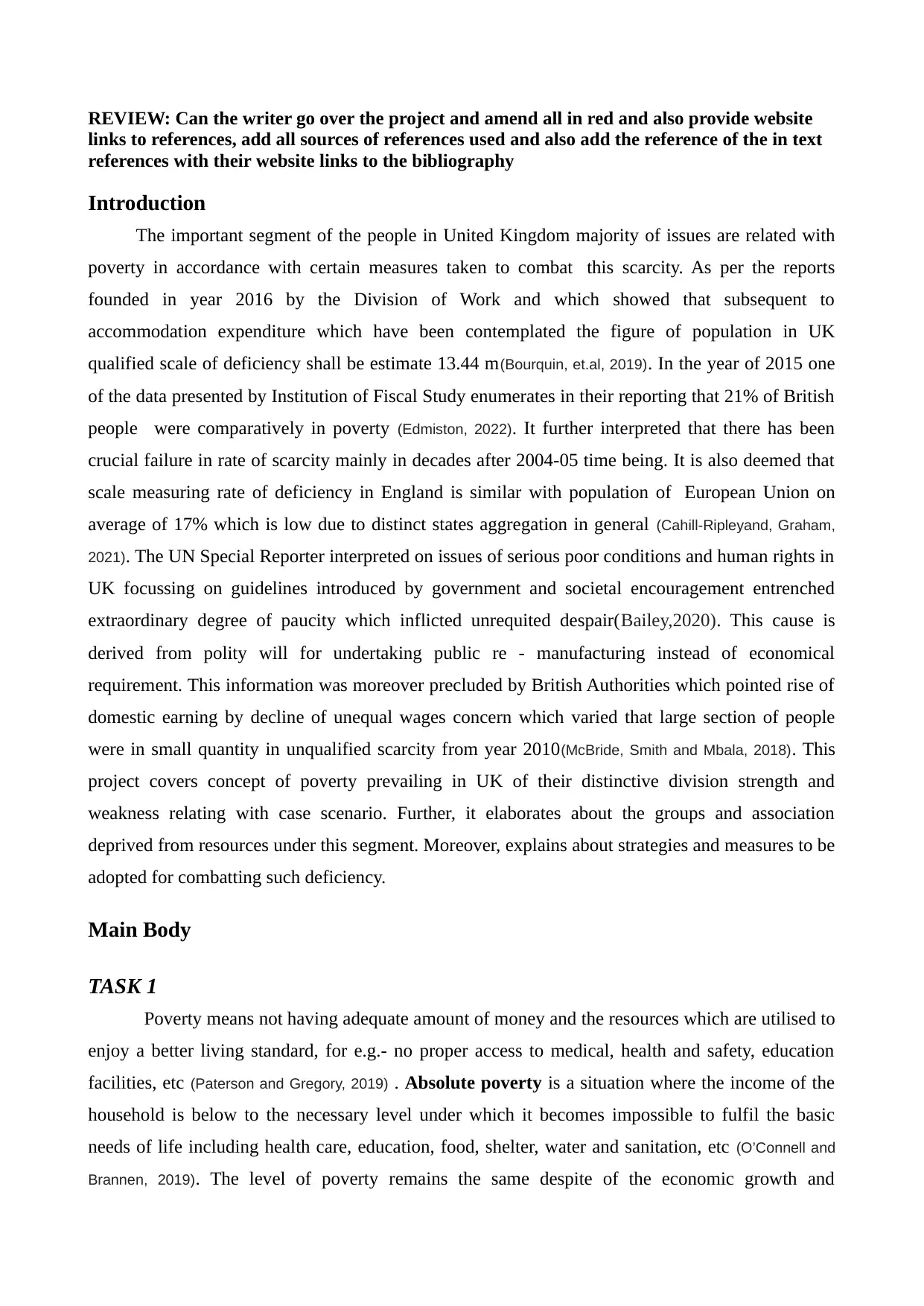
REVIEW: Can the writer go over the project and amend all in red and also provide website
links to references, add all sources of references used and also add the reference of the in text
references with their website links to the bibliography
Introduction
The important segment of the people in United Kingdom majority of issues are related with
poverty in accordance with certain measures taken to combat this scarcity. As per the reports
founded in year 2016 by the Division of Work and which showed that subsequent to
accommodation expenditure which have been contemplated the figure of population in UK
qualified scale of deficiency shall be estimate 13.44 m(Bourquin, et.al, 2019). In the year of 2015 one
of the data presented by Institution of Fiscal Study enumerates in their reporting that 21% of British
people were comparatively in poverty (Edmiston, 2022). It further interpreted that there has been
crucial failure in rate of scarcity mainly in decades after 2004-05 time being. It is also deemed that
scale measuring rate of deficiency in England is similar with population of European Union on
average of 17% which is low due to distinct states aggregation in general (Cahill-Ripleyand, Graham,
2021). The UN Special Reporter interpreted on issues of serious poor conditions and human rights in
UK focussing on guidelines introduced by government and societal encouragement entrenched
extraordinary degree of paucity which inflicted unrequited despair(Bailey,2020). This cause is
derived from polity will for undertaking public re - manufacturing instead of economical
requirement. This information was moreover precluded by British Authorities which pointed rise of
domestic earning by decline of unequal wages concern which varied that large section of people
were in small quantity in unqualified scarcity from year 2010(McBride, Smith and Mbala, 2018). This
project covers concept of poverty prevailing in UK of their distinctive division strength and
weakness relating with case scenario. Further, it elaborates about the groups and association
deprived from resources under this segment. Moreover, explains about strategies and measures to be
adopted for combatting such deficiency.
Main Body
TASK 1
Poverty means not having adequate amount of money and the resources which are utilised to
enjoy a better living standard, for e.g.- no proper access to medical, health and safety, education
facilities, etc (Paterson and Gregory, 2019) . Absolute poverty is a situation where the income of the
household is below to the necessary level under which it becomes impossible to fulfil the basic
needs of life including health care, education, food, shelter, water and sanitation, etc (O’Connell and
Brannen, 2019). The level of poverty remains the same despite of the economic growth and
links to references, add all sources of references used and also add the reference of the in text
references with their website links to the bibliography
Introduction
The important segment of the people in United Kingdom majority of issues are related with
poverty in accordance with certain measures taken to combat this scarcity. As per the reports
founded in year 2016 by the Division of Work and which showed that subsequent to
accommodation expenditure which have been contemplated the figure of population in UK
qualified scale of deficiency shall be estimate 13.44 m(Bourquin, et.al, 2019). In the year of 2015 one
of the data presented by Institution of Fiscal Study enumerates in their reporting that 21% of British
people were comparatively in poverty (Edmiston, 2022). It further interpreted that there has been
crucial failure in rate of scarcity mainly in decades after 2004-05 time being. It is also deemed that
scale measuring rate of deficiency in England is similar with population of European Union on
average of 17% which is low due to distinct states aggregation in general (Cahill-Ripleyand, Graham,
2021). The UN Special Reporter interpreted on issues of serious poor conditions and human rights in
UK focussing on guidelines introduced by government and societal encouragement entrenched
extraordinary degree of paucity which inflicted unrequited despair(Bailey,2020). This cause is
derived from polity will for undertaking public re - manufacturing instead of economical
requirement. This information was moreover precluded by British Authorities which pointed rise of
domestic earning by decline of unequal wages concern which varied that large section of people
were in small quantity in unqualified scarcity from year 2010(McBride, Smith and Mbala, 2018). This
project covers concept of poverty prevailing in UK of their distinctive division strength and
weakness relating with case scenario. Further, it elaborates about the groups and association
deprived from resources under this segment. Moreover, explains about strategies and measures to be
adopted for combatting such deficiency.
Main Body
TASK 1
Poverty means not having adequate amount of money and the resources which are utilised to
enjoy a better living standard, for e.g.- no proper access to medical, health and safety, education
facilities, etc (Paterson and Gregory, 2019) . Absolute poverty is a situation where the income of the
household is below to the necessary level under which it becomes impossible to fulfil the basic
needs of life including health care, education, food, shelter, water and sanitation, etc (O’Connell and
Brannen, 2019). The level of poverty remains the same despite of the economic growth and
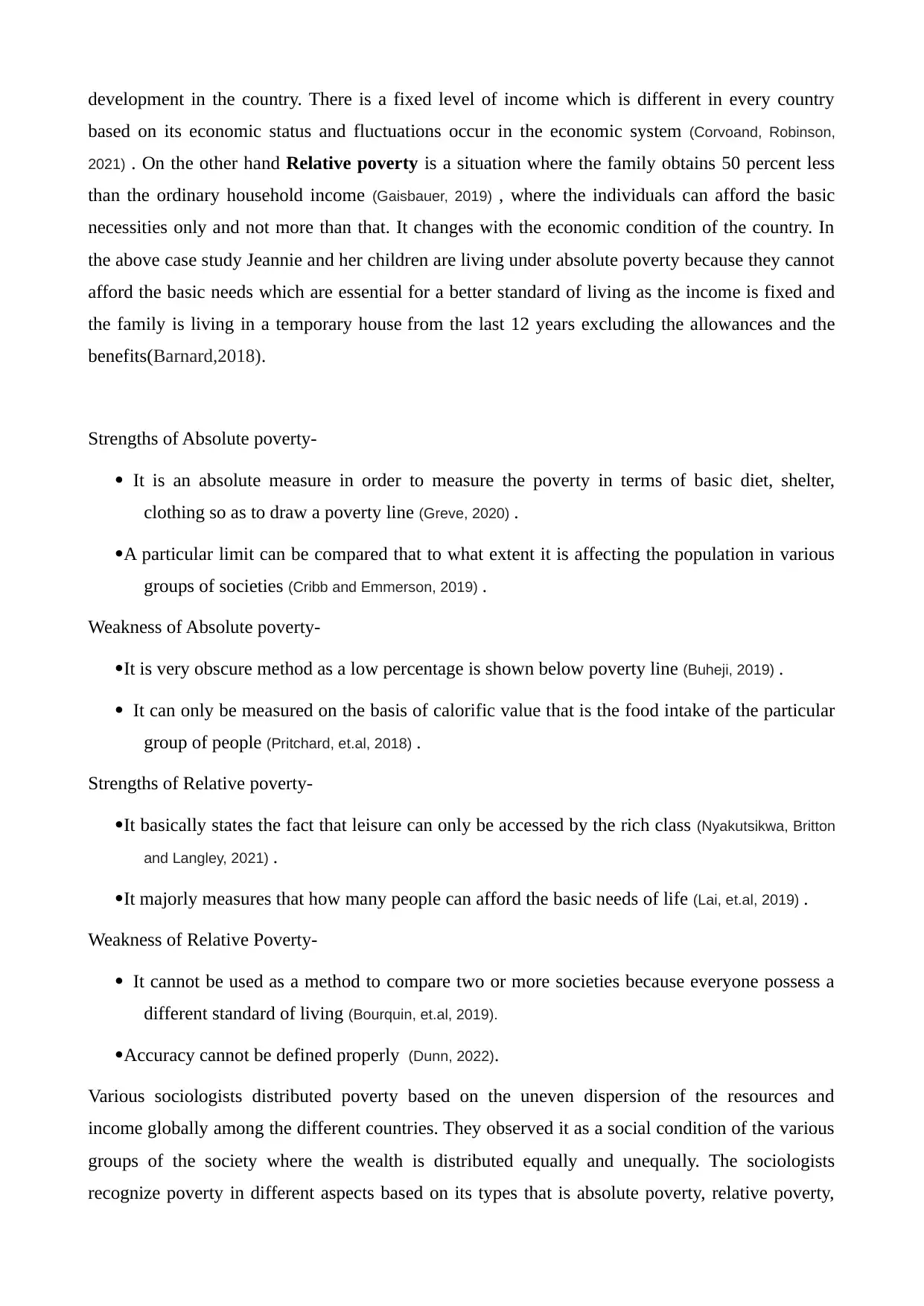
development in the country. There is a fixed level of income which is different in every country
based on its economic status and fluctuations occur in the economic system (Corvoand, Robinson,
2021) . On the other hand Relative poverty is a situation where the family obtains 50 percent less
than the ordinary household income (Gaisbauer, 2019) , where the individuals can afford the basic
necessities only and not more than that. It changes with the economic condition of the country. In
the above case study Jeannie and her children are living under absolute poverty because they cannot
afford the basic needs which are essential for a better standard of living as the income is fixed and
the family is living in a temporary house from the last 12 years excluding the allowances and the
benefits(Barnard,2018).
Strengths of Absolute poverty-
It is an absolute measure in order to measure the poverty in terms of basic diet, shelter,
clothing so as to draw a poverty line (Greve, 2020) .
A particular limit can be compared that to what extent it is affecting the population in various
groups of societies (Cribb and Emmerson, 2019) .
Weakness of Absolute poverty-
It is very obscure method as a low percentage is shown below poverty line (Buheji, 2019) .
It can only be measured on the basis of calorific value that is the food intake of the particular
group of people (Pritchard, et.al, 2018) .
Strengths of Relative poverty-
It basically states the fact that leisure can only be accessed by the rich class (Nyakutsikwa, Britton
and Langley, 2021) .
It majorly measures that how many people can afford the basic needs of life (Lai, et.al, 2019) .
Weakness of Relative Poverty-
It cannot be used as a method to compare two or more societies because everyone possess a
different standard of living (Bourquin, et.al, 2019).
Accuracy cannot be defined properly (Dunn, 2022).
Various sociologists distributed poverty based on the uneven dispersion of the resources and
income globally among the different countries. They observed it as a social condition of the various
groups of the society where the wealth is distributed equally and unequally. The sociologists
recognize poverty in different aspects based on its types that is absolute poverty, relative poverty,
based on its economic status and fluctuations occur in the economic system (Corvoand, Robinson,
2021) . On the other hand Relative poverty is a situation where the family obtains 50 percent less
than the ordinary household income (Gaisbauer, 2019) , where the individuals can afford the basic
necessities only and not more than that. It changes with the economic condition of the country. In
the above case study Jeannie and her children are living under absolute poverty because they cannot
afford the basic needs which are essential for a better standard of living as the income is fixed and
the family is living in a temporary house from the last 12 years excluding the allowances and the
benefits(Barnard,2018).
Strengths of Absolute poverty-
It is an absolute measure in order to measure the poverty in terms of basic diet, shelter,
clothing so as to draw a poverty line (Greve, 2020) .
A particular limit can be compared that to what extent it is affecting the population in various
groups of societies (Cribb and Emmerson, 2019) .
Weakness of Absolute poverty-
It is very obscure method as a low percentage is shown below poverty line (Buheji, 2019) .
It can only be measured on the basis of calorific value that is the food intake of the particular
group of people (Pritchard, et.al, 2018) .
Strengths of Relative poverty-
It basically states the fact that leisure can only be accessed by the rich class (Nyakutsikwa, Britton
and Langley, 2021) .
It majorly measures that how many people can afford the basic needs of life (Lai, et.al, 2019) .
Weakness of Relative Poverty-
It cannot be used as a method to compare two or more societies because everyone possess a
different standard of living (Bourquin, et.al, 2019).
Accuracy cannot be defined properly (Dunn, 2022).
Various sociologists distributed poverty based on the uneven dispersion of the resources and
income globally among the different countries. They observed it as a social condition of the various
groups of the society where the wealth is distributed equally and unequally. The sociologists
recognize poverty in different aspects based on its types that is absolute poverty, relative poverty,
⊘ This is a preview!⊘
Do you want full access?
Subscribe today to unlock all pages.

Trusted by 1+ million students worldwide
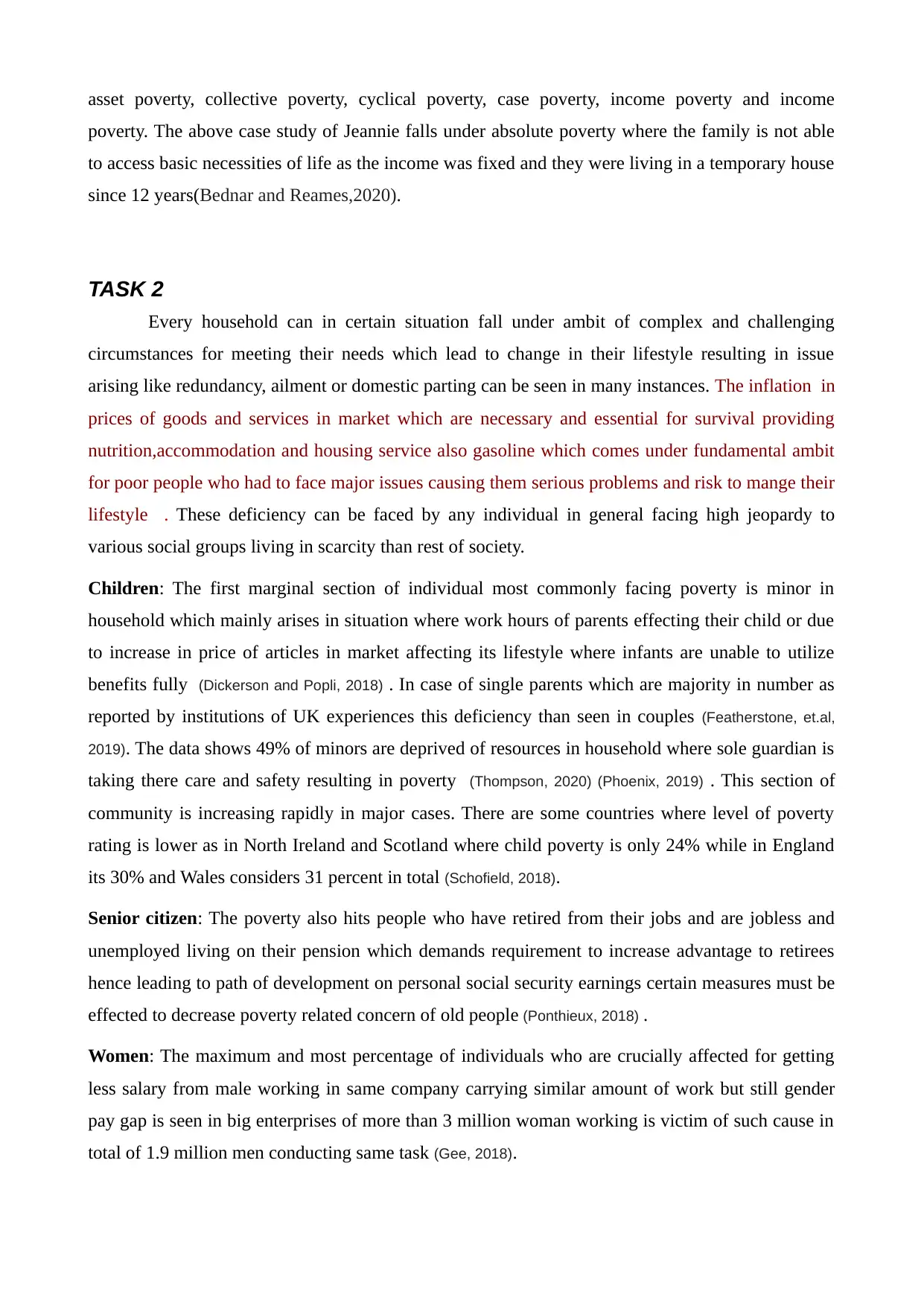
asset poverty, collective poverty, cyclical poverty, case poverty, income poverty and income
poverty. The above case study of Jeannie falls under absolute poverty where the family is not able
to access basic necessities of life as the income was fixed and they were living in a temporary house
since 12 years(Bednar and Reames,2020).
TASK 2
Every household can in certain situation fall under ambit of complex and challenging
circumstances for meeting their needs which lead to change in their lifestyle resulting in issue
arising like redundancy, ailment or domestic parting can be seen in many instances. The inflation in
prices of goods and services in market which are necessary and essential for survival providing
nutrition,accommodation and housing service also gasoline which comes under fundamental ambit
for poor people who had to face major issues causing them serious problems and risk to mange their
lifestyle . These deficiency can be faced by any individual in general facing high jeopardy to
various social groups living in scarcity than rest of society.
Children: The first marginal section of individual most commonly facing poverty is minor in
household which mainly arises in situation where work hours of parents effecting their child or due
to increase in price of articles in market affecting its lifestyle where infants are unable to utilize
benefits fully (Dickerson and Popli, 2018) . In case of single parents which are majority in number as
reported by institutions of UK experiences this deficiency than seen in couples (Featherstone, et.al,
2019). The data shows 49% of minors are deprived of resources in household where sole guardian is
taking there care and safety resulting in poverty (Thompson, 2020) (Phoenix, 2019) . This section of
community is increasing rapidly in major cases. There are some countries where level of poverty
rating is lower as in North Ireland and Scotland where child poverty is only 24% while in England
its 30% and Wales considers 31 percent in total (Schofield, 2018).
Senior citizen: The poverty also hits people who have retired from their jobs and are jobless and
unemployed living on their pension which demands requirement to increase advantage to retirees
hence leading to path of development on personal social security earnings certain measures must be
effected to decrease poverty related concern of old people (Ponthieux, 2018) .
Women: The maximum and most percentage of individuals who are crucially affected for getting
less salary from male working in same company carrying similar amount of work but still gender
pay gap is seen in big enterprises of more than 3 million woman working is victim of such cause in
total of 1.9 million men conducting same task (Gee, 2018).
poverty. The above case study of Jeannie falls under absolute poverty where the family is not able
to access basic necessities of life as the income was fixed and they were living in a temporary house
since 12 years(Bednar and Reames,2020).
TASK 2
Every household can in certain situation fall under ambit of complex and challenging
circumstances for meeting their needs which lead to change in their lifestyle resulting in issue
arising like redundancy, ailment or domestic parting can be seen in many instances. The inflation in
prices of goods and services in market which are necessary and essential for survival providing
nutrition,accommodation and housing service also gasoline which comes under fundamental ambit
for poor people who had to face major issues causing them serious problems and risk to mange their
lifestyle . These deficiency can be faced by any individual in general facing high jeopardy to
various social groups living in scarcity than rest of society.
Children: The first marginal section of individual most commonly facing poverty is minor in
household which mainly arises in situation where work hours of parents effecting their child or due
to increase in price of articles in market affecting its lifestyle where infants are unable to utilize
benefits fully (Dickerson and Popli, 2018) . In case of single parents which are majority in number as
reported by institutions of UK experiences this deficiency than seen in couples (Featherstone, et.al,
2019). The data shows 49% of minors are deprived of resources in household where sole guardian is
taking there care and safety resulting in poverty (Thompson, 2020) (Phoenix, 2019) . This section of
community is increasing rapidly in major cases. There are some countries where level of poverty
rating is lower as in North Ireland and Scotland where child poverty is only 24% while in England
its 30% and Wales considers 31 percent in total (Schofield, 2018).
Senior citizen: The poverty also hits people who have retired from their jobs and are jobless and
unemployed living on their pension which demands requirement to increase advantage to retirees
hence leading to path of development on personal social security earnings certain measures must be
effected to decrease poverty related concern of old people (Ponthieux, 2018) .
Women: The maximum and most percentage of individuals who are crucially affected for getting
less salary from male working in same company carrying similar amount of work but still gender
pay gap is seen in big enterprises of more than 3 million woman working is victim of such cause in
total of 1.9 million men conducting same task (Gee, 2018).
Paraphrase This Document
Need a fresh take? Get an instant paraphrase of this document with our AI Paraphraser
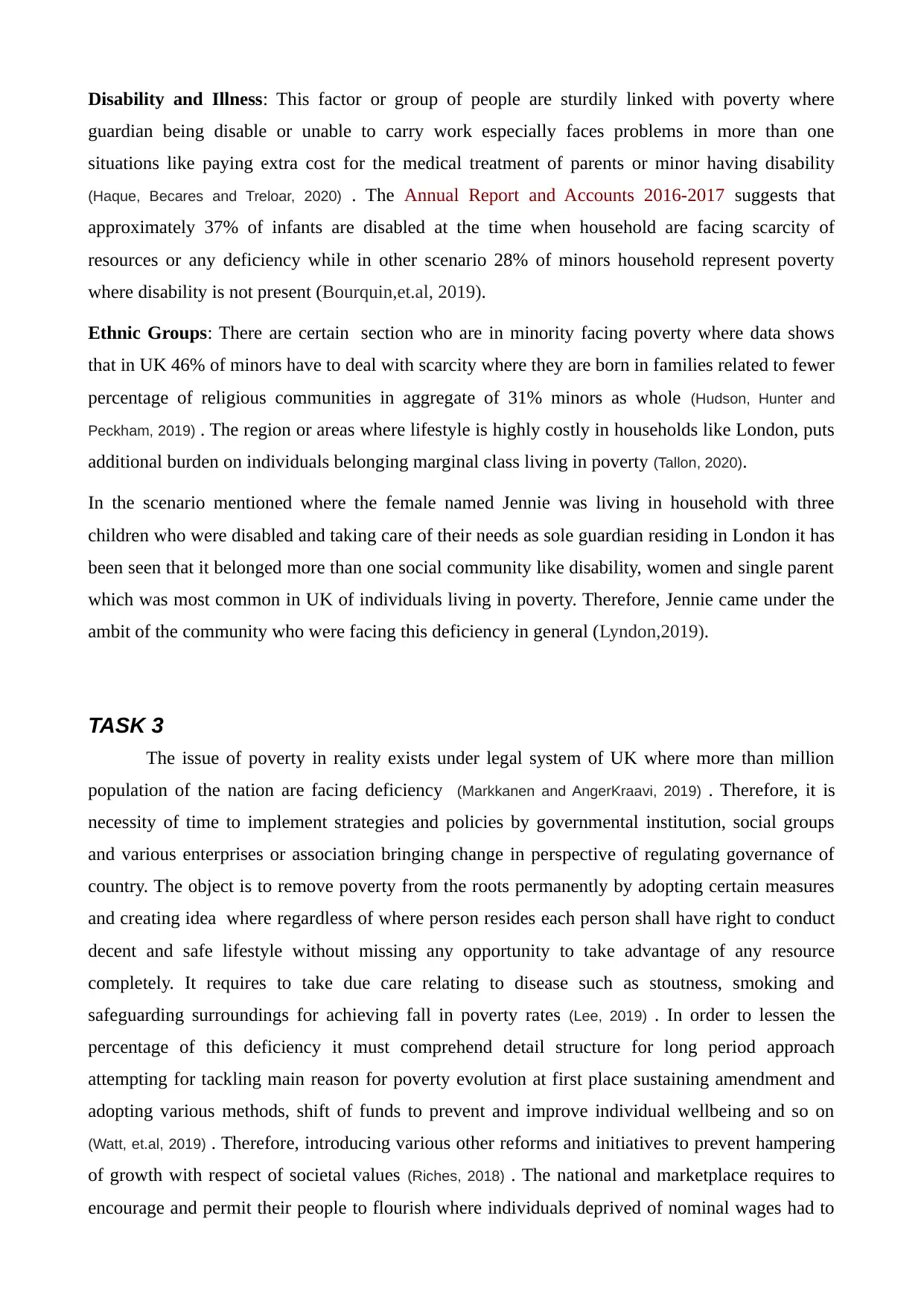
Disability and Illness: This factor or group of people are sturdily linked with poverty where
guardian being disable or unable to carry work especially faces problems in more than one
situations like paying extra cost for the medical treatment of parents or minor having disability
(Haque, Becares and Treloar, 2020) . The Annual Report and Accounts 2016-2017 suggests that
approximately 37% of infants are disabled at the time when household are facing scarcity of
resources or any deficiency while in other scenario 28% of minors household represent poverty
where disability is not present (Bourquin,et.al, 2019).
Ethnic Groups: There are certain section who are in minority facing poverty where data shows
that in UK 46% of minors have to deal with scarcity where they are born in families related to fewer
percentage of religious communities in aggregate of 31% minors as whole (Hudson, Hunter and
Peckham, 2019) . The region or areas where lifestyle is highly costly in households like London, puts
additional burden on individuals belonging marginal class living in poverty (Tallon, 2020).
In the scenario mentioned where the female named Jennie was living in household with three
children who were disabled and taking care of their needs as sole guardian residing in London it has
been seen that it belonged more than one social community like disability, women and single parent
which was most common in UK of individuals living in poverty. Therefore, Jennie came under the
ambit of the community who were facing this deficiency in general (Lyndon,2019).
TASK 3
The issue of poverty in reality exists under legal system of UK where more than million
population of the nation are facing deficiency (Markkanen and AngerKraavi, 2019) . Therefore, it is
necessity of time to implement strategies and policies by governmental institution, social groups
and various enterprises or association bringing change in perspective of regulating governance of
country. The object is to remove poverty from the roots permanently by adopting certain measures
and creating idea where regardless of where person resides each person shall have right to conduct
decent and safe lifestyle without missing any opportunity to take advantage of any resource
completely. It requires to take due care relating to disease such as stoutness, smoking and
safeguarding surroundings for achieving fall in poverty rates (Lee, 2019) . In order to lessen the
percentage of this deficiency it must comprehend detail structure for long period approach
attempting for tackling main reason for poverty evolution at first place sustaining amendment and
adopting various methods, shift of funds to prevent and improve individual wellbeing and so on
(Watt, et.al, 2019) . Therefore, introducing various other reforms and initiatives to prevent hampering
of growth with respect of societal values (Riches, 2018) . The national and marketplace requires to
encourage and permit their people to flourish where individuals deprived of nominal wages had to
guardian being disable or unable to carry work especially faces problems in more than one
situations like paying extra cost for the medical treatment of parents or minor having disability
(Haque, Becares and Treloar, 2020) . The Annual Report and Accounts 2016-2017 suggests that
approximately 37% of infants are disabled at the time when household are facing scarcity of
resources or any deficiency while in other scenario 28% of minors household represent poverty
where disability is not present (Bourquin,et.al, 2019).
Ethnic Groups: There are certain section who are in minority facing poverty where data shows
that in UK 46% of minors have to deal with scarcity where they are born in families related to fewer
percentage of religious communities in aggregate of 31% minors as whole (Hudson, Hunter and
Peckham, 2019) . The region or areas where lifestyle is highly costly in households like London, puts
additional burden on individuals belonging marginal class living in poverty (Tallon, 2020).
In the scenario mentioned where the female named Jennie was living in household with three
children who were disabled and taking care of their needs as sole guardian residing in London it has
been seen that it belonged more than one social community like disability, women and single parent
which was most common in UK of individuals living in poverty. Therefore, Jennie came under the
ambit of the community who were facing this deficiency in general (Lyndon,2019).
TASK 3
The issue of poverty in reality exists under legal system of UK where more than million
population of the nation are facing deficiency (Markkanen and AngerKraavi, 2019) . Therefore, it is
necessity of time to implement strategies and policies by governmental institution, social groups
and various enterprises or association bringing change in perspective of regulating governance of
country. The object is to remove poverty from the roots permanently by adopting certain measures
and creating idea where regardless of where person resides each person shall have right to conduct
decent and safe lifestyle without missing any opportunity to take advantage of any resource
completely. It requires to take due care relating to disease such as stoutness, smoking and
safeguarding surroundings for achieving fall in poverty rates (Lee, 2019) . In order to lessen the
percentage of this deficiency it must comprehend detail structure for long period approach
attempting for tackling main reason for poverty evolution at first place sustaining amendment and
adopting various methods, shift of funds to prevent and improve individual wellbeing and so on
(Watt, et.al, 2019) . Therefore, introducing various other reforms and initiatives to prevent hampering
of growth with respect of societal values (Riches, 2018) . The national and marketplace requires to
encourage and permit their people to flourish where individuals deprived of nominal wages had to
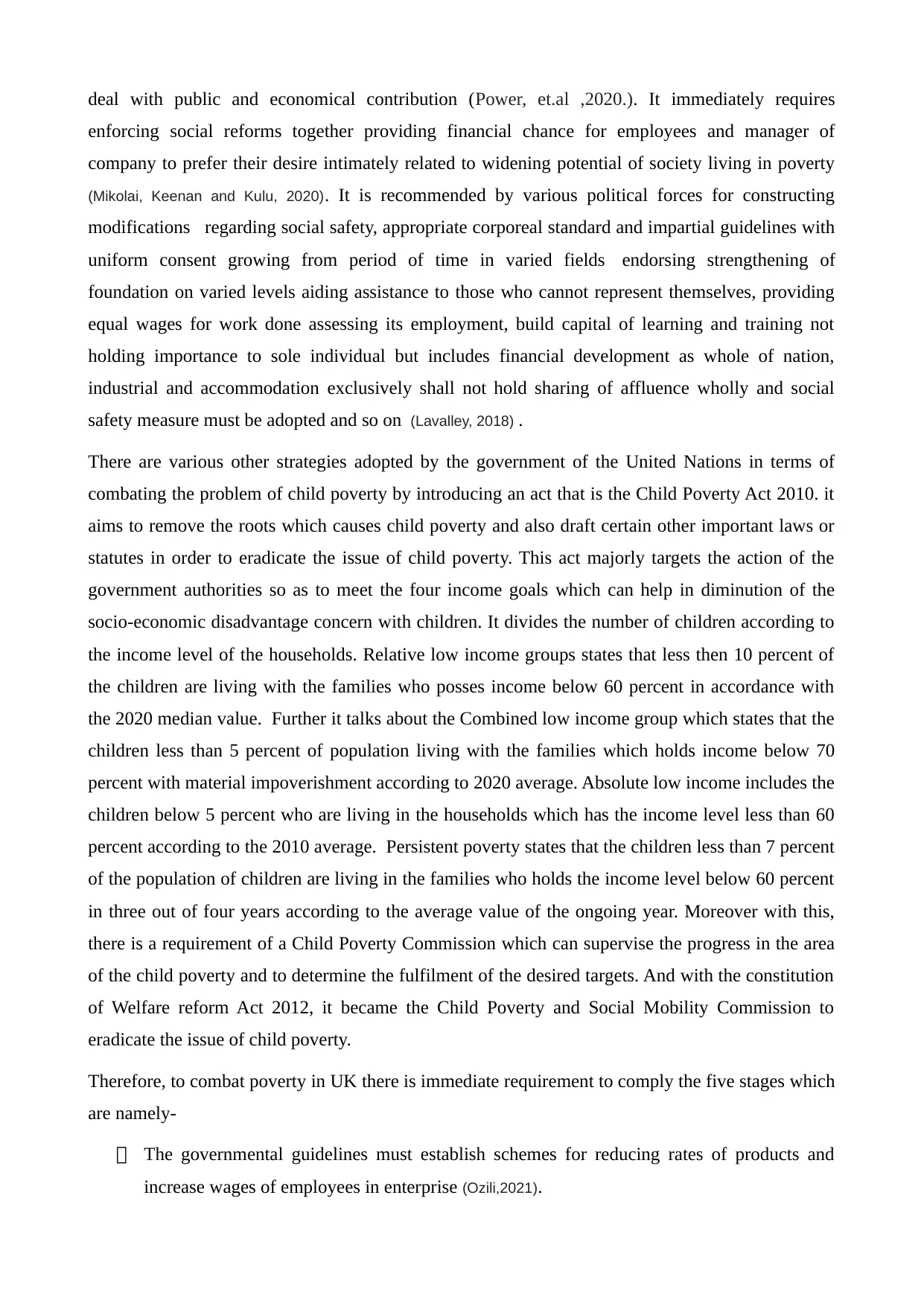
deal with public and economical contribution (Power, et.al ,2020.). It immediately requires
enforcing social reforms together providing financial chance for employees and manager of
company to prefer their desire intimately related to widening potential of society living in poverty
(Mikolai, Keenan and Kulu, 2020). It is recommended by various political forces for constructing
modifications regarding social safety, appropriate corporeal standard and impartial guidelines with
uniform consent growing from period of time in varied fields endorsing strengthening of
foundation on varied levels aiding assistance to those who cannot represent themselves, providing
equal wages for work done assessing its employment, build capital of learning and training not
holding importance to sole individual but includes financial development as whole of nation,
industrial and accommodation exclusively shall not hold sharing of affluence wholly and social
safety measure must be adopted and so on (Lavalley, 2018) .
There are various other strategies adopted by the government of the United Nations in terms of
combating the problem of child poverty by introducing an act that is the Child Poverty Act 2010. it
aims to remove the roots which causes child poverty and also draft certain other important laws or
statutes in order to eradicate the issue of child poverty. This act majorly targets the action of the
government authorities so as to meet the four income goals which can help in diminution of the
socio-economic disadvantage concern with children. It divides the number of children according to
the income level of the households. Relative low income groups states that less then 10 percent of
the children are living with the families who posses income below 60 percent in accordance with
the 2020 median value. Further it talks about the Combined low income group which states that the
children less than 5 percent of population living with the families which holds income below 70
percent with material impoverishment according to 2020 average. Absolute low income includes the
children below 5 percent who are living in the households which has the income level less than 60
percent according to the 2010 average. Persistent poverty states that the children less than 7 percent
of the population of children are living in the families who holds the income level below 60 percent
in three out of four years according to the average value of the ongoing year. Moreover with this,
there is a requirement of a Child Poverty Commission which can supervise the progress in the area
of the child poverty and to determine the fulfilment of the desired targets. And with the constitution
of Welfare reform Act 2012, it became the Child Poverty and Social Mobility Commission to
eradicate the issue of child poverty.
Therefore, to combat poverty in UK there is immediate requirement to comply the five stages which
are namely-
The governmental guidelines must establish schemes for reducing rates of products and
increase wages of employees in enterprise (Ozili,2021).
enforcing social reforms together providing financial chance for employees and manager of
company to prefer their desire intimately related to widening potential of society living in poverty
(Mikolai, Keenan and Kulu, 2020). It is recommended by various political forces for constructing
modifications regarding social safety, appropriate corporeal standard and impartial guidelines with
uniform consent growing from period of time in varied fields endorsing strengthening of
foundation on varied levels aiding assistance to those who cannot represent themselves, providing
equal wages for work done assessing its employment, build capital of learning and training not
holding importance to sole individual but includes financial development as whole of nation,
industrial and accommodation exclusively shall not hold sharing of affluence wholly and social
safety measure must be adopted and so on (Lavalley, 2018) .
There are various other strategies adopted by the government of the United Nations in terms of
combating the problem of child poverty by introducing an act that is the Child Poverty Act 2010. it
aims to remove the roots which causes child poverty and also draft certain other important laws or
statutes in order to eradicate the issue of child poverty. This act majorly targets the action of the
government authorities so as to meet the four income goals which can help in diminution of the
socio-economic disadvantage concern with children. It divides the number of children according to
the income level of the households. Relative low income groups states that less then 10 percent of
the children are living with the families who posses income below 60 percent in accordance with
the 2020 median value. Further it talks about the Combined low income group which states that the
children less than 5 percent of population living with the families which holds income below 70
percent with material impoverishment according to 2020 average. Absolute low income includes the
children below 5 percent who are living in the households which has the income level less than 60
percent according to the 2010 average. Persistent poverty states that the children less than 7 percent
of the population of children are living in the families who holds the income level below 60 percent
in three out of four years according to the average value of the ongoing year. Moreover with this,
there is a requirement of a Child Poverty Commission which can supervise the progress in the area
of the child poverty and to determine the fulfilment of the desired targets. And with the constitution
of Welfare reform Act 2012, it became the Child Poverty and Social Mobility Commission to
eradicate the issue of child poverty.
Therefore, to combat poverty in UK there is immediate requirement to comply the five stages which
are namely-
The governmental guidelines must establish schemes for reducing rates of products and
increase wages of employees in enterprise (Ozili,2021).
⊘ This is a preview!⊘
Do you want full access?
Subscribe today to unlock all pages.

Trusted by 1+ million students worldwide
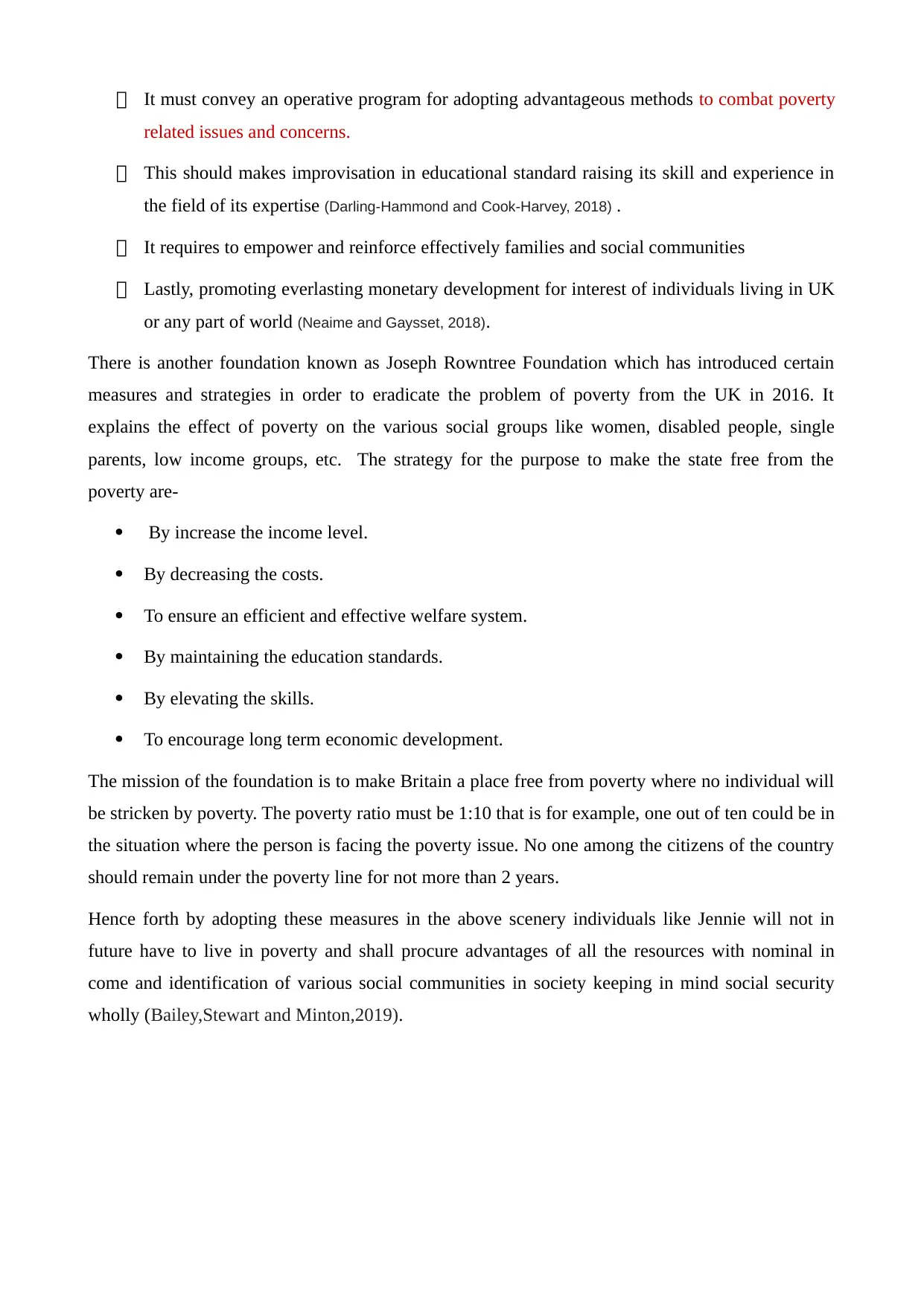
It must convey an operative program for adopting advantageous methods to combat poverty
related issues and concerns.
This should makes improvisation in educational standard raising its skill and experience in
the field of its expertise (Darling-Hammond and Cook-Harvey, 2018) .
It requires to empower and reinforce effectively families and social communities
Lastly, promoting everlasting monetary development for interest of individuals living in UK
or any part of world (Neaime and Gaysset, 2018).
There is another foundation known as Joseph Rowntree Foundation which has introduced certain
measures and strategies in order to eradicate the problem of poverty from the UK in 2016. It
explains the effect of poverty on the various social groups like women, disabled people, single
parents, low income groups, etc. The strategy for the purpose to make the state free from the
poverty are-
By increase the income level.
By decreasing the costs.
To ensure an efficient and effective welfare system.
By maintaining the education standards.
By elevating the skills.
To encourage long term economic development.
The mission of the foundation is to make Britain a place free from poverty where no individual will
be stricken by poverty. The poverty ratio must be 1:10 that is for example, one out of ten could be in
the situation where the person is facing the poverty issue. No one among the citizens of the country
should remain under the poverty line for not more than 2 years.
Hence forth by adopting these measures in the above scenery individuals like Jennie will not in
future have to live in poverty and shall procure advantages of all the resources with nominal in
come and identification of various social communities in society keeping in mind social security
wholly (Bailey,Stewart and Minton,2019).
related issues and concerns.
This should makes improvisation in educational standard raising its skill and experience in
the field of its expertise (Darling-Hammond and Cook-Harvey, 2018) .
It requires to empower and reinforce effectively families and social communities
Lastly, promoting everlasting monetary development for interest of individuals living in UK
or any part of world (Neaime and Gaysset, 2018).
There is another foundation known as Joseph Rowntree Foundation which has introduced certain
measures and strategies in order to eradicate the problem of poverty from the UK in 2016. It
explains the effect of poverty on the various social groups like women, disabled people, single
parents, low income groups, etc. The strategy for the purpose to make the state free from the
poverty are-
By increase the income level.
By decreasing the costs.
To ensure an efficient and effective welfare system.
By maintaining the education standards.
By elevating the skills.
To encourage long term economic development.
The mission of the foundation is to make Britain a place free from poverty where no individual will
be stricken by poverty. The poverty ratio must be 1:10 that is for example, one out of ten could be in
the situation where the person is facing the poverty issue. No one among the citizens of the country
should remain under the poverty line for not more than 2 years.
Hence forth by adopting these measures in the above scenery individuals like Jennie will not in
future have to live in poverty and shall procure advantages of all the resources with nominal in
come and identification of various social communities in society keeping in mind social security
wholly (Bailey,Stewart and Minton,2019).
Paraphrase This Document
Need a fresh take? Get an instant paraphrase of this document with our AI Paraphraser
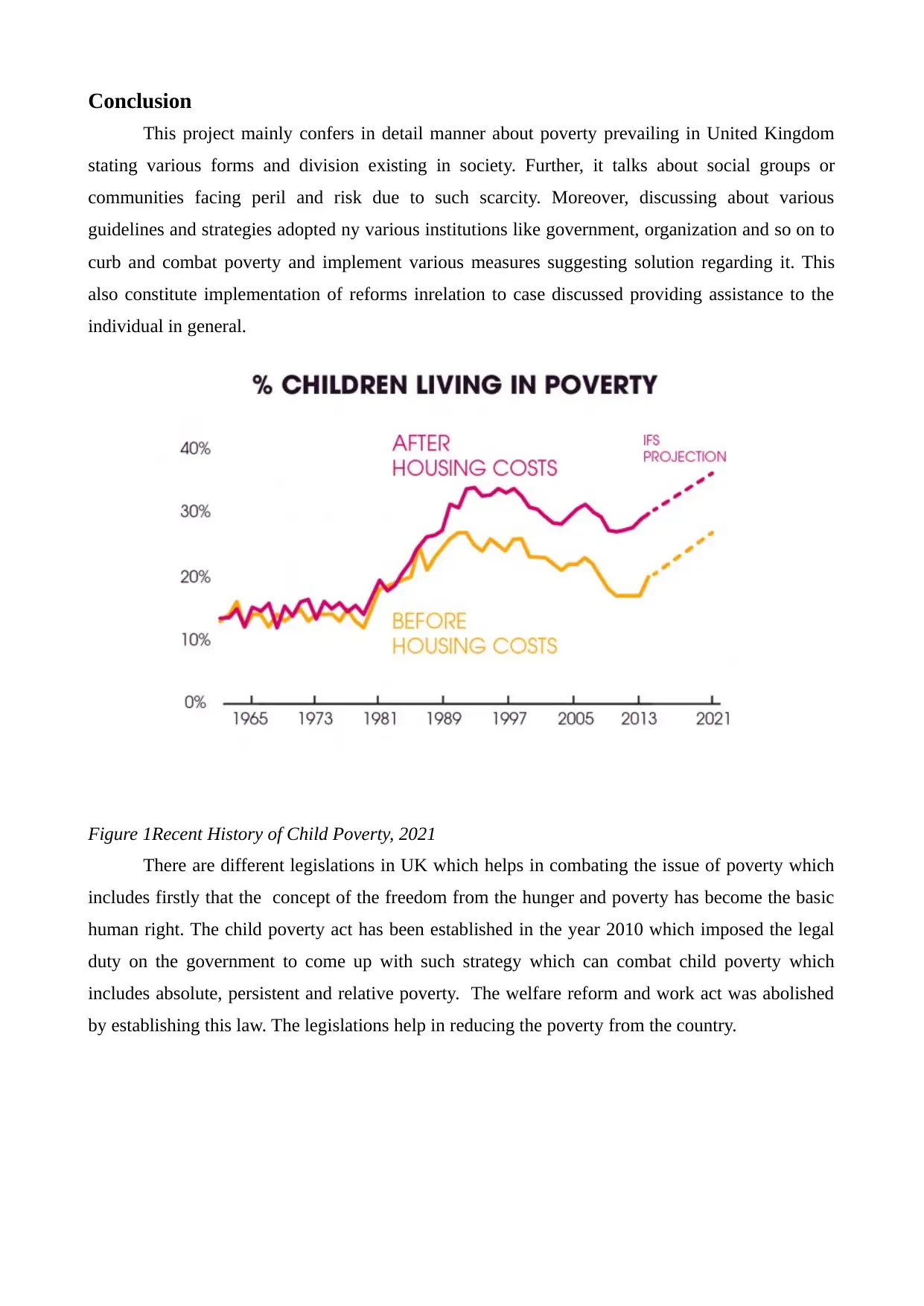
Conclusion
This project mainly confers in detail manner about poverty prevailing in United Kingdom
stating various forms and division existing in society. Further, it talks about social groups or
communities facing peril and risk due to such scarcity. Moreover, discussing about various
guidelines and strategies adopted ny various institutions like government, organization and so on to
curb and combat poverty and implement various measures suggesting solution regarding it. This
also constitute implementation of reforms inrelation to case discussed providing assistance to the
individual in general.
Figure 1Recent History of Child Poverty, 2021
There are different legislations in UK which helps in combating the issue of poverty which
includes firstly that the concept of the freedom from the hunger and poverty has become the basic
human right. The child poverty act has been established in the year 2010 which imposed the legal
duty on the government to come up with such strategy which can combat child poverty which
includes absolute, persistent and relative poverty. The welfare reform and work act was abolished
by establishing this law. The legislations help in reducing the poverty from the country.
This project mainly confers in detail manner about poverty prevailing in United Kingdom
stating various forms and division existing in society. Further, it talks about social groups or
communities facing peril and risk due to such scarcity. Moreover, discussing about various
guidelines and strategies adopted ny various institutions like government, organization and so on to
curb and combat poverty and implement various measures suggesting solution regarding it. This
also constitute implementation of reforms inrelation to case discussed providing assistance to the
individual in general.
Figure 1Recent History of Child Poverty, 2021
There are different legislations in UK which helps in combating the issue of poverty which
includes firstly that the concept of the freedom from the hunger and poverty has become the basic
human right. The child poverty act has been established in the year 2010 which imposed the legal
duty on the government to come up with such strategy which can combat child poverty which
includes absolute, persistent and relative poverty. The welfare reform and work act was abolished
by establishing this law. The legislations help in reducing the poverty from the country.

⊘ This is a preview!⊘
Do you want full access?
Subscribe today to unlock all pages.

Trusted by 1+ million students worldwide
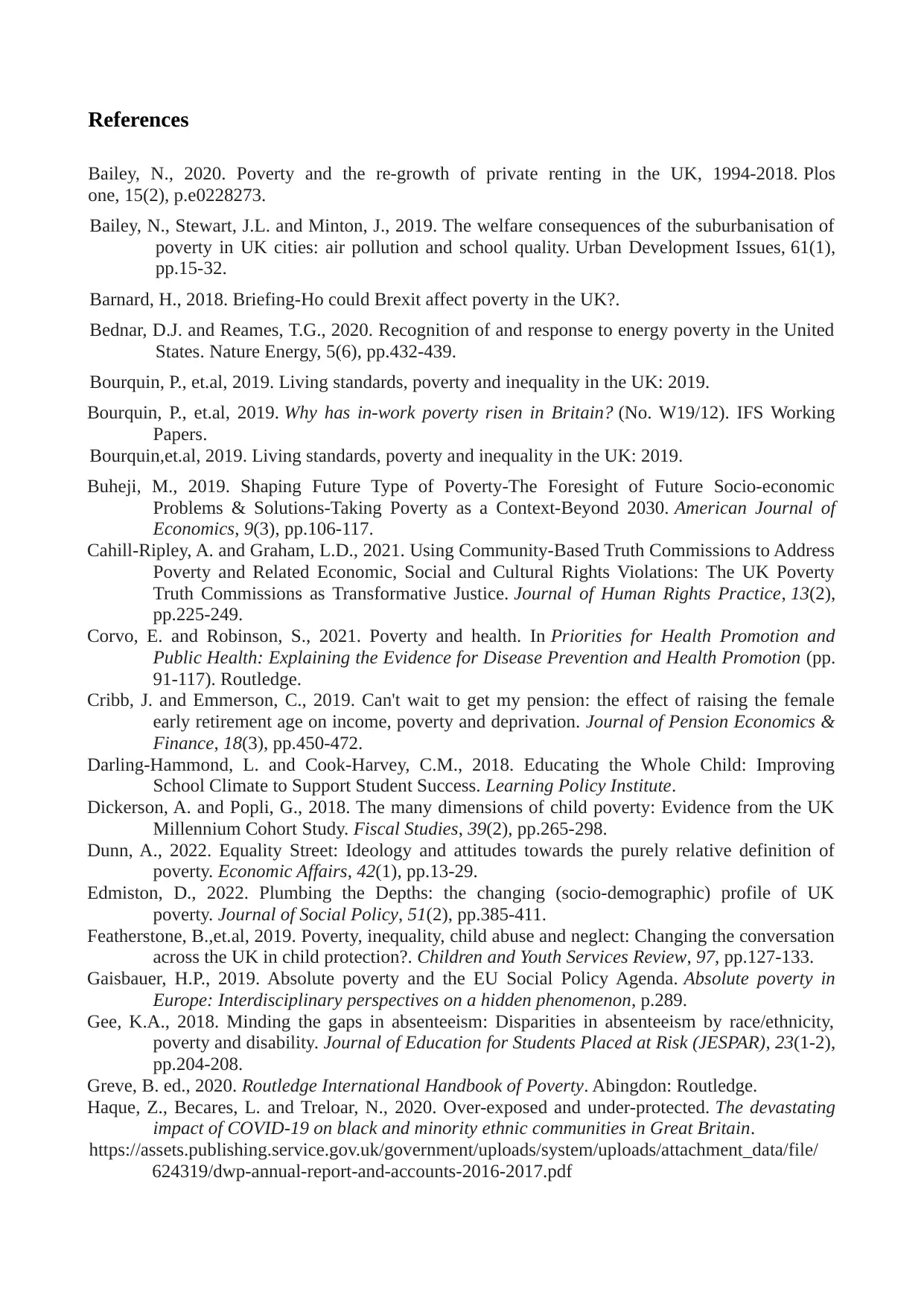
References
Bailey, N., 2020. Poverty and the re-growth of private renting in the UK, 1994-2018. Plos
one, 15(2), p.e0228273.
Bailey, N., Stewart, J.L. and Minton, J., 2019. The welfare consequences of the suburbanisation of
poverty in UK cities: air pollution and school quality. Urban Development Issues, 61(1),
pp.15-32.
Barnard, H., 2018. Briefing-Ho could Brexit affect poverty in the UK?.
Bednar, D.J. and Reames, T.G., 2020. Recognition of and response to energy poverty in the United
States. Nature Energy, 5(6), pp.432-439.
Bourquin, P., et.al, 2019. Living standards, poverty and inequality in the UK: 2019.
Bourquin, P., et.al, 2019. Why has in-work poverty risen in Britain? (No. W19/12). IFS Working
Papers.
Bourquin,et.al, 2019. Living standards, poverty and inequality in the UK: 2019.
Buheji, M., 2019. Shaping Future Type of Poverty-The Foresight of Future Socio-economic
Problems & Solutions-Taking Poverty as a Context-Beyond 2030. American Journal of
Economics, 9(3), pp.106-117.
Cahill-Ripley, A. and Graham, L.D., 2021. Using Community-Based Truth Commissions to Address
Poverty and Related Economic, Social and Cultural Rights Violations: The UK Poverty
Truth Commissions as Transformative Justice. Journal of Human Rights Practice, 13(2),
pp.225-249.
Corvo, E. and Robinson, S., 2021. Poverty and health. In Priorities for Health Promotion and
Public Health: Explaining the Evidence for Disease Prevention and Health Promotion (pp.
91-117). Routledge.
Cribb, J. and Emmerson, C., 2019. Can't wait to get my pension: the effect of raising the female
early retirement age on income, poverty and deprivation. Journal of Pension Economics &
Finance, 18(3), pp.450-472.
Darling-Hammond, L. and Cook-Harvey, C.M., 2018. Educating the Whole Child: Improving
School Climate to Support Student Success. Learning Policy Institute.
Dickerson, A. and Popli, G., 2018. The many dimensions of child poverty: Evidence from the UK
Millennium Cohort Study. Fiscal Studies, 39(2), pp.265-298.
Dunn, A., 2022. Equality Street: Ideology and attitudes towards the purely relative definition of
poverty. Economic Affairs, 42(1), pp.13-29.
Edmiston, D., 2022. Plumbing the Depths: the changing (socio-demographic) profile of UK
poverty. Journal of Social Policy, 51(2), pp.385-411.
Featherstone, B.,et.al, 2019. Poverty, inequality, child abuse and neglect: Changing the conversation
across the UK in child protection?. Children and Youth Services Review, 97, pp.127-133.
Gaisbauer, H.P., 2019. Absolute poverty and the EU Social Policy Agenda. Absolute poverty in
Europe: Interdisciplinary perspectives on a hidden phenomenon, p.289.
Gee, K.A., 2018. Minding the gaps in absenteeism: Disparities in absenteeism by race/ethnicity,
poverty and disability. Journal of Education for Students Placed at Risk (JESPAR), 23(1-2),
pp.204-208.
Greve, B. ed., 2020. Routledge International Handbook of Poverty. Abingdon: Routledge.
Haque, Z., Becares, L. and Treloar, N., 2020. Over-exposed and under-protected. The devastating
impact of COVID-19 on black and minority ethnic communities in Great Britain.
https://assets.publishing.service.gov.uk/government/uploads/system/uploads/attachment_data/file/
624319/dwp-annual-report-and-accounts-2016-2017.pdf
Bailey, N., 2020. Poverty and the re-growth of private renting in the UK, 1994-2018. Plos
one, 15(2), p.e0228273.
Bailey, N., Stewart, J.L. and Minton, J., 2019. The welfare consequences of the suburbanisation of
poverty in UK cities: air pollution and school quality. Urban Development Issues, 61(1),
pp.15-32.
Barnard, H., 2018. Briefing-Ho could Brexit affect poverty in the UK?.
Bednar, D.J. and Reames, T.G., 2020. Recognition of and response to energy poverty in the United
States. Nature Energy, 5(6), pp.432-439.
Bourquin, P., et.al, 2019. Living standards, poverty and inequality in the UK: 2019.
Bourquin, P., et.al, 2019. Why has in-work poverty risen in Britain? (No. W19/12). IFS Working
Papers.
Bourquin,et.al, 2019. Living standards, poverty and inequality in the UK: 2019.
Buheji, M., 2019. Shaping Future Type of Poverty-The Foresight of Future Socio-economic
Problems & Solutions-Taking Poverty as a Context-Beyond 2030. American Journal of
Economics, 9(3), pp.106-117.
Cahill-Ripley, A. and Graham, L.D., 2021. Using Community-Based Truth Commissions to Address
Poverty and Related Economic, Social and Cultural Rights Violations: The UK Poverty
Truth Commissions as Transformative Justice. Journal of Human Rights Practice, 13(2),
pp.225-249.
Corvo, E. and Robinson, S., 2021. Poverty and health. In Priorities for Health Promotion and
Public Health: Explaining the Evidence for Disease Prevention and Health Promotion (pp.
91-117). Routledge.
Cribb, J. and Emmerson, C., 2019. Can't wait to get my pension: the effect of raising the female
early retirement age on income, poverty and deprivation. Journal of Pension Economics &
Finance, 18(3), pp.450-472.
Darling-Hammond, L. and Cook-Harvey, C.M., 2018. Educating the Whole Child: Improving
School Climate to Support Student Success. Learning Policy Institute.
Dickerson, A. and Popli, G., 2018. The many dimensions of child poverty: Evidence from the UK
Millennium Cohort Study. Fiscal Studies, 39(2), pp.265-298.
Dunn, A., 2022. Equality Street: Ideology and attitudes towards the purely relative definition of
poverty. Economic Affairs, 42(1), pp.13-29.
Edmiston, D., 2022. Plumbing the Depths: the changing (socio-demographic) profile of UK
poverty. Journal of Social Policy, 51(2), pp.385-411.
Featherstone, B.,et.al, 2019. Poverty, inequality, child abuse and neglect: Changing the conversation
across the UK in child protection?. Children and Youth Services Review, 97, pp.127-133.
Gaisbauer, H.P., 2019. Absolute poverty and the EU Social Policy Agenda. Absolute poverty in
Europe: Interdisciplinary perspectives on a hidden phenomenon, p.289.
Gee, K.A., 2018. Minding the gaps in absenteeism: Disparities in absenteeism by race/ethnicity,
poverty and disability. Journal of Education for Students Placed at Risk (JESPAR), 23(1-2),
pp.204-208.
Greve, B. ed., 2020. Routledge International Handbook of Poverty. Abingdon: Routledge.
Haque, Z., Becares, L. and Treloar, N., 2020. Over-exposed and under-protected. The devastating
impact of COVID-19 on black and minority ethnic communities in Great Britain.
https://assets.publishing.service.gov.uk/government/uploads/system/uploads/attachment_data/file/
624319/dwp-annual-report-and-accounts-2016-2017.pdf
Paraphrase This Document
Need a fresh take? Get an instant paraphrase of this document with our AI Paraphraser
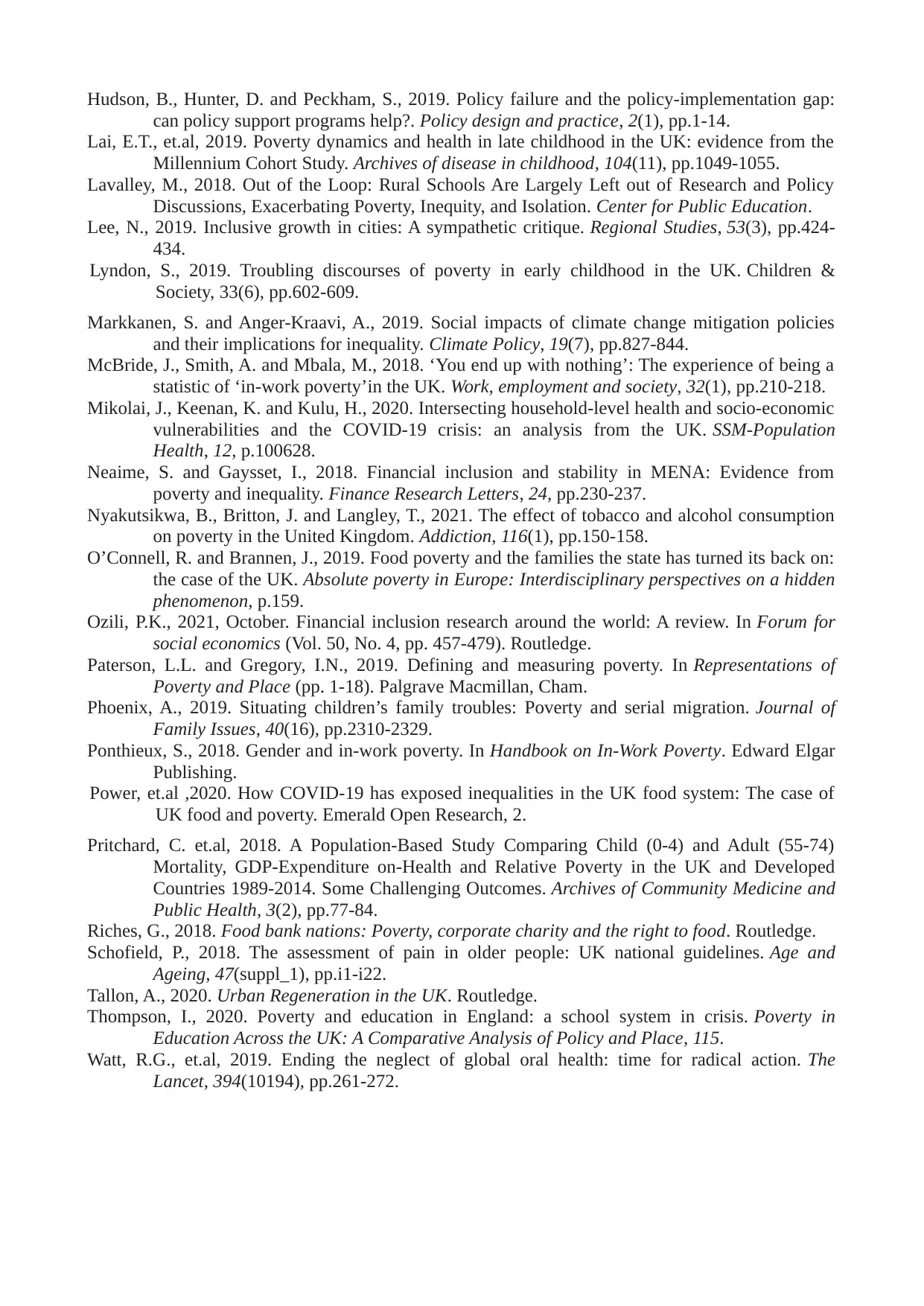
Hudson, B., Hunter, D. and Peckham, S., 2019. Policy failure and the policy-implementation gap:
can policy support programs help?. Policy design and practice, 2(1), pp.1-14.
Lai, E.T., et.al, 2019. Poverty dynamics and health in late childhood in the UK: evidence from the
Millennium Cohort Study. Archives of disease in childhood, 104(11), pp.1049-1055.
Lavalley, M., 2018. Out of the Loop: Rural Schools Are Largely Left out of Research and Policy
Discussions, Exacerbating Poverty, Inequity, and Isolation. Center for Public Education.
Lee, N., 2019. Inclusive growth in cities: A sympathetic critique. Regional Studies, 53(3), pp.424-
434.
Lyndon, S., 2019. Troubling discourses of poverty in early childhood in the UK. Children &
Society, 33(6), pp.602-609.
Markkanen, S. and Anger-Kraavi, A., 2019. Social impacts of climate change mitigation policies
and their implications for inequality. Climate Policy, 19(7), pp.827-844.
McBride, J., Smith, A. and Mbala, M., 2018. ‘You end up with nothing’: The experience of being a
statistic of ‘in-work poverty’in the UK. Work, employment and society, 32(1), pp.210-218.
Mikolai, J., Keenan, K. and Kulu, H., 2020. Intersecting household-level health and socio-economic
vulnerabilities and the COVID-19 crisis: an analysis from the UK. SSM-Population
Health, 12, p.100628.
Neaime, S. and Gaysset, I., 2018. Financial inclusion and stability in MENA: Evidence from
poverty and inequality. Finance Research Letters, 24, pp.230-237.
Nyakutsikwa, B., Britton, J. and Langley, T., 2021. The effect of tobacco and alcohol consumption
on poverty in the United Kingdom. Addiction, 116(1), pp.150-158.
O’Connell, R. and Brannen, J., 2019. Food poverty and the families the state has turned its back on:
the case of the UK. Absolute poverty in Europe: Interdisciplinary perspectives on a hidden
phenomenon, p.159.
Ozili, P.K., 2021, October. Financial inclusion research around the world: A review. In Forum for
social economics (Vol. 50, No. 4, pp. 457-479). Routledge.
Paterson, L.L. and Gregory, I.N., 2019. Defining and measuring poverty. In Representations of
Poverty and Place (pp. 1-18). Palgrave Macmillan, Cham.
Phoenix, A., 2019. Situating children’s family troubles: Poverty and serial migration. Journal of
Family Issues, 40(16), pp.2310-2329.
Ponthieux, S., 2018. Gender and in-work poverty. In Handbook on In-Work Poverty. Edward Elgar
Publishing.
Power, et.al ,2020. How COVID-19 has exposed inequalities in the UK food system: The case of
UK food and poverty. Emerald Open Research, 2.
Pritchard, C. et.al, 2018. A Population-Based Study Comparing Child (0-4) and Adult (55-74)
Mortality, GDP-Expenditure on-Health and Relative Poverty in the UK and Developed
Countries 1989-2014. Some Challenging Outcomes. Archives of Community Medicine and
Public Health, 3(2), pp.77-84.
Riches, G., 2018. Food bank nations: Poverty, corporate charity and the right to food. Routledge.
Schofield, P., 2018. The assessment of pain in older people: UK national guidelines. Age and
Ageing, 47(suppl_1), pp.i1-i22.
Tallon, A., 2020. Urban Regeneration in the UK. Routledge.
Thompson, I., 2020. Poverty and education in England: a school system in crisis. Poverty in
Education Across the UK: A Comparative Analysis of Policy and Place, 115.
Watt, R.G., et.al, 2019. Ending the neglect of global oral health: time for radical action. The
Lancet, 394(10194), pp.261-272.
can policy support programs help?. Policy design and practice, 2(1), pp.1-14.
Lai, E.T., et.al, 2019. Poverty dynamics and health in late childhood in the UK: evidence from the
Millennium Cohort Study. Archives of disease in childhood, 104(11), pp.1049-1055.
Lavalley, M., 2018. Out of the Loop: Rural Schools Are Largely Left out of Research and Policy
Discussions, Exacerbating Poverty, Inequity, and Isolation. Center for Public Education.
Lee, N., 2019. Inclusive growth in cities: A sympathetic critique. Regional Studies, 53(3), pp.424-
434.
Lyndon, S., 2019. Troubling discourses of poverty in early childhood in the UK. Children &
Society, 33(6), pp.602-609.
Markkanen, S. and Anger-Kraavi, A., 2019. Social impacts of climate change mitigation policies
and their implications for inequality. Climate Policy, 19(7), pp.827-844.
McBride, J., Smith, A. and Mbala, M., 2018. ‘You end up with nothing’: The experience of being a
statistic of ‘in-work poverty’in the UK. Work, employment and society, 32(1), pp.210-218.
Mikolai, J., Keenan, K. and Kulu, H., 2020. Intersecting household-level health and socio-economic
vulnerabilities and the COVID-19 crisis: an analysis from the UK. SSM-Population
Health, 12, p.100628.
Neaime, S. and Gaysset, I., 2018. Financial inclusion and stability in MENA: Evidence from
poverty and inequality. Finance Research Letters, 24, pp.230-237.
Nyakutsikwa, B., Britton, J. and Langley, T., 2021. The effect of tobacco and alcohol consumption
on poverty in the United Kingdom. Addiction, 116(1), pp.150-158.
O’Connell, R. and Brannen, J., 2019. Food poverty and the families the state has turned its back on:
the case of the UK. Absolute poverty in Europe: Interdisciplinary perspectives on a hidden
phenomenon, p.159.
Ozili, P.K., 2021, October. Financial inclusion research around the world: A review. In Forum for
social economics (Vol. 50, No. 4, pp. 457-479). Routledge.
Paterson, L.L. and Gregory, I.N., 2019. Defining and measuring poverty. In Representations of
Poverty and Place (pp. 1-18). Palgrave Macmillan, Cham.
Phoenix, A., 2019. Situating children’s family troubles: Poverty and serial migration. Journal of
Family Issues, 40(16), pp.2310-2329.
Ponthieux, S., 2018. Gender and in-work poverty. In Handbook on In-Work Poverty. Edward Elgar
Publishing.
Power, et.al ,2020. How COVID-19 has exposed inequalities in the UK food system: The case of
UK food and poverty. Emerald Open Research, 2.
Pritchard, C. et.al, 2018. A Population-Based Study Comparing Child (0-4) and Adult (55-74)
Mortality, GDP-Expenditure on-Health and Relative Poverty in the UK and Developed
Countries 1989-2014. Some Challenging Outcomes. Archives of Community Medicine and
Public Health, 3(2), pp.77-84.
Riches, G., 2018. Food bank nations: Poverty, corporate charity and the right to food. Routledge.
Schofield, P., 2018. The assessment of pain in older people: UK national guidelines. Age and
Ageing, 47(suppl_1), pp.i1-i22.
Tallon, A., 2020. Urban Regeneration in the UK. Routledge.
Thompson, I., 2020. Poverty and education in England: a school system in crisis. Poverty in
Education Across the UK: A Comparative Analysis of Policy and Place, 115.
Watt, R.G., et.al, 2019. Ending the neglect of global oral health: time for radical action. The
Lancet, 394(10194), pp.261-272.
1 out of 11
Related Documents
Your All-in-One AI-Powered Toolkit for Academic Success.
+13062052269
info@desklib.com
Available 24*7 on WhatsApp / Email
![[object Object]](/_next/static/media/star-bottom.7253800d.svg)
Unlock your academic potential
Copyright © 2020–2025 A2Z Services. All Rights Reserved. Developed and managed by ZUCOL.





